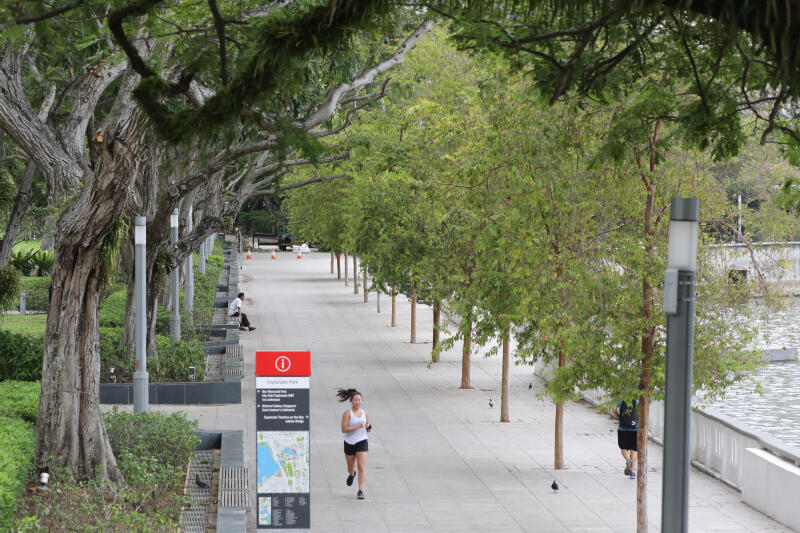Coronavirus: Keep at least 10m away if running behind someone to avoid infection, say researchers
Sign up now: Get ST's newsletters delivered to your inbox

European scientists have found that Covid-19 may spread further than 1m when one is running or cycling behind an infected individual.
ST PHOTO: ONG WEE JIN
Timothy Goh
Follow topic:
SINGAPORE - Thinking about exercising in a crowded park to get out of the house this long weekend? Think again.
Under Singapore's circuit breaker measures, individuals are allowed to leave their homes to exercise in a park, but must maintain a safe distance of at least 1m from others to avoid infection.
However, new research by European scientists has found that Covid-19 may spread further than this distance when one is running or cycling behind an infected individual.
A white paper from the Netherlands' Eindhoven University of Technology and Belgium's KU Leuven said that those walking behind someone should keep 4m to 5m away instead, while those running or cycling slowly behind someone doing the same should keep at least 10m away. This distance extends to 20m if one is cycling at high speeds.
This is because of the air currents produced by the person in the front, also known as a slipstream.
Professor Bert Blocken, one of the researchers, explained: "If someone exhales, coughs or sneezes while walking, running or cycling, most of the micro-droplets are entrained in the wake or slipstream behind (them). The other person who runs or cycles just behind this leading person in the slipstream then moves through that cloud of droplets."
Together with his team, Prof Blocken, who is an expert in civil engineering, used a computer program to simulate the release of saliva particles from people who were walking or running at different speeds, in different formations.
The simulations found that two people walking or running side by side in calm weather were least at risk of infecting each other, as the droplets they produced would end up behind them.
Those who moved in a staggered formation - one diagonally behind the other - were also not very likely to catch saliva droplets from each other.
But those who walked or ran closely behind each other, and ended up in each other's slipstream, were at greatest risk of contamination, said the researchers.
The researchers noted that their white paper was not a peer-reviewed article, but added that they would be publishing one later and had decided to release the results of their study earlier due to the current worldwide crisis.
"The 1.5m distance rule announced by several governments is very effective for people who stand still indoors or outdoors in calm weather. But those who go walking, running or cycling should be a bit more careful," said Prof Blocken.
Whether an exercise setting raises a person's risk of infection is still the subject of debate here.
Infectious diseases expert Paul Tambyah said: "During exercise, we take short breaths more frequently, so theoretically, the risk is lower compared with singing or deep breathing."
Prof Tambyah, who is from the NUS Yong Loo Lin School of Medicine, added that he was not aware of anyone getting infected while exercising outdoors.
But another infectious diseases expert, Dr Leong Hoe Nam, said: "The harder you pant, the higher the chance that (infectious particles) will be expelled. Theoretically, when you're running and are panting, you also breathe in harder, causing the particles to go deeper into the lungs and thus increasing the risk of infection."
However, he added that a person who is sick would usually not be cycling or running.
He also dispelled the myth that the heat would prevent one from catching the coronavirus while exercising in the sun.
He said: "You still need a bit of time for the virus to die after exposure to heat.
"Between a cyclist or runner coughing out and the person behind breathing in, you're talking about a 1-2 second difference. That exposure time is insufficient."
But both experts agreed that data on the subject is lacking, and said that it is important to avoid crowds while exercising.
"I think there's no harm in maintaining a longer safety distance of 4m to 5m, and not bunching up while running. You should also only run with your household members, because (you've already been exposed to them)," said Dr Leong.
Prof Tambyah agreed. "Right now, it is probably safer to avoid crowds anywhere - whether in a park or supermarket... The ideal is to stay at home and exercise on your own."

